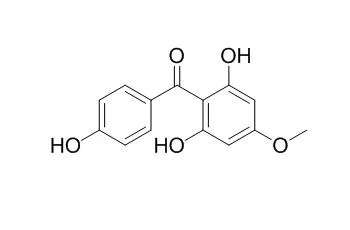| Description: |
2,6,4'-Trihydroxy-4-methoxybenzophenone shows weak inhibitory activity of testosterone 5alpha-reductase, it also shows significant inhibition of pancreatic lipase activity. 2,6,4'-Trihydroxy-4-methoxybenzophenone has neurotrophic activity, it induced neurite outgrowth in PC-12 cells at concentration of 50 microg/ml. 2,6,4′-Trihydroxy-4-methoxybenzophenone exhibits low cytotoxic effect against HeLa and 3T3 cell lines with IC50 values of 132 ug/ml and 158 ug/ml, repectively. It also shows antioxidant activity on DPPH with IC50 of 10.57 ug/mL. |
| In vitro: |
| Biol Pharm Bull. 2005 Sep;28(9):1798-800. | | 7-hydroxy-3-(4-hydroxybenzyl)chroman and broussonin b: neurotrophic compounds, isolated from Anemarrhena asphodeloides BUNGE, function as proteasome inhibitors.[Pubmed: 16141565] |
METHODS AND RESULTS:
The extract of Anemarrhenae Rhizoma (rhizomes of Anemarrhena asphodeloides BUNGE) showed neurotrophic activity toward rat pheochromocytoma (PC-12) cells. Bioassay-guided purification afforded four compounds, 2,6,4'-Trihydroxy-4-methoxybenzophenone (1), 7-hydroxy-3-(4-hydroxybenzyl)chroman (2), broussonin B (3), and cis-hinokiresinol (4).
CONCLUSIONS:
Compounds 1-3 induced neurite outgrowth in PC-12 cells at concentration of 50 microg/ml, while 4 was less active. In addition, compounds 2-4 showed moderate inhibitory activities against a chymotrypsin-like activity of the proteasome. | | Biol Pharm Bull. 2001 May;24(5):586-7. | | Testosterone 5alpha-reductase inhibitory active constituents from Anemarrhenae Rhizoma.[Pubmed: 11379787] |
METHODS AND RESULTS:
The diethyl ether extract of Anemarrhenae Rhizoma (rhizomes of Anemarrhena asphodeloides Bunge) showed testosterone 5alpha-reductase inhibitory activity.
CONCLUSIONS:
Two major constituents, cis-hinokiresinol (1) and 2,6,4'-Trihydroxy-4-methoxybenzophenone (2) were identified as the active principles. The inhibitory activity of 1 was superior to that of ethinylestradiol, but that of 2 was weak. | | Jurnal Teknologi, 2013, 64(2). | | Cytotoxic Activity of Major Compounds from Phaleria macrocarpa (Scheff.) Boerl. Fruits.[Reference: WebLink] | P. macrocarpa is a well known Indonesian medicinal plant which is traditionally claimed to have anticancer properties. To date, there are numerous cytotoxic studies conducted on crude extracts of this plant. However, there are limited informations available regarding cytotoxic activity of the compounds isolated from this plant.
METHODS AND RESULTS:
Thus, this study investigated cytotoxic activity of two benzophenones derivatives identified as 2,6,4'-Trihydroxy-4-methoxybenzophenone(1) and 6,4′-dihydroxy-4-methoxybenzophenone-2-O-β-D-glucopyranoside (2) isolated from the ethyl acetate extract. Cytotoxic activities of these compounds were performed against human cervical carcinoma cell line (HeLa) and mouse embryonic fibroblast cell line (3T3) using MTT assay.
CONCLUSIONS:
The result showed that benzophenone (1) exhibited low cytotoxic effect against HeLa and 3T3 cell lines with IC50 values of 132 μg/ml and 158 μg/ml, repectively while benzophenone (2) was non toxic against HeLa and 3T3 cell lines are because the IC50 is more than 250 μg/ml. These findings may sheds light on the actual properties of this plant. | | Nat Prod Commun. 2013 Apr;8(4):481-3. | | Inhibitory activity of benzophenones from Anemarrhena asphodeloides on pancreatic lipase.[Pubmed: 23738459] | | Pancreatic lipase is a key enzyme for lipid absorption by hydrolysis of total dietary fats. Therefore, inhibition of pancreatic lipase is suggested to be an effective therapy in the regulation of obesity. The EtOAc-soluble fraction of Anemarrhena asphodeloides rhizomes significantly inhibited pancreatic lipase activity as assessed using porcine pancreatic lipase as an in vitro assay system. Further fractionation of the EtOAc-soluble fraction of A. asphodeloides led to the isolation of a new benzophenone glycoside, zimoside A (1), together with the eleven known compounds iriflophenone (2), 2,4',6-trihydroxy-4-methoxybenzophenone (2,6,4'-Trihydroxy-4-methoxybenzophenone
,3), foliamangiferoside A (4), (2,3-dihydroxy-4-methoxyphenyl)(4-hydroxyphenyl)-methanone (5), 1,4,5,6,-tetrahydroxyxanthone (6), isosakuranetin (7), 4-hydroxybenzoic acid (8), 4-hydroxyacetophenone (9), vanillic acid (10), tyrosol (11) and 5-hydroxymethyl-2-furaldehyde (12). Among the isolated compounds, 3, 5 and 10 showed significant inhibition of pancreatic lipase activity. |
|






 Cell. 2018 Jan 11;172(1-2):249-261.e12. doi: 10.1016/j.cell.2017.12.019.IF=36.216(2019)
Cell. 2018 Jan 11;172(1-2):249-261.e12. doi: 10.1016/j.cell.2017.12.019.IF=36.216(2019) Cell Metab. 2020 Mar 3;31(3):534-548.e5. doi: 10.1016/j.cmet.2020.01.002.IF=22.415(2019)
Cell Metab. 2020 Mar 3;31(3):534-548.e5. doi: 10.1016/j.cmet.2020.01.002.IF=22.415(2019) Mol Cell. 2017 Nov 16;68(4):673-685.e6. doi: 10.1016/j.molcel.2017.10.022.IF=14.548(2019)
Mol Cell. 2017 Nov 16;68(4):673-685.e6. doi: 10.1016/j.molcel.2017.10.022.IF=14.548(2019)